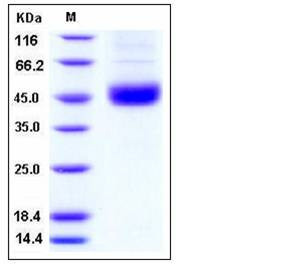Human SMYD2 / KMT3C Protein (His Tag)
HSKM-B,KMT3C,ZMYND14
- 100ug (NPP4279) Please inquiry
| Catalog Number | P11093-H07B |
|---|---|
| Organism Species | Human |
| Host | Baculovirus-Insect Cells |
| Synonyms | HSKM-B,KMT3C,ZMYND14 |
| Molecular Weight | The recombinant human SMYD2 consists of 451 amino acids and predicts a molecular mass of 52 kDa. It migrates as an approximately 48 kDa band in SDS-PAGE under reducing conditions. |
| predicted N | His |
| SDS-PAGE |  |
| Purity | > 97 % as determined by SDS-PAGE |
| Protein Construction | A DNA sequence encoding the full length of human SMYD2 (NP_064582.2) (Met 1-His 433) was expressed, with a polyhistidine tag at the N-terminus. |
| Bio-activity | |
| Research Area | Epigenetics |Histone Modifying Enzymes |Methylation and Demethylation |Histone methylation |
| Formulation | Lyophilized from sterile 50mM Tris, 100mM NaCl, 10% glycedrol, pH 8.0 1. Normally 5 % - 8 % trehalose, mannitol and 0.01% Tween80 are added as protectants before lyophilization. Specific concentrations are included in the hardcopy of COA. |
| Background | SET and MYND domain-containing protein 2, also known as HSKM-B, SMYD2, and KMT3C, is a member of the SMYD protein family. It contains one MYND-type zinc finger and one SET domain. Not much is known about SMYD2. However, the interest in better understanding the roles of SMYD2 has grown because of reports indicating that SMYD2 methylates p53 and histone H3. In Xenopus, SMYD1 and SMYD2 were expressed in various muscle tissues and related to muscle cells differentiation. SMYD2 mRNA is most highly expressed in heart and brain tissue. Over-expressed SMYD2 localizes to the cytoplasm and the nucleus in 293T cells. SMYD2 appears to restrain cell proliferation, likely through direct modulation of chromatin structure. Patients with SMYD2-overexpressing tumors had a worse overall rate of survival than those with non-expressing tumors, and SMYD2 positivity was independently associated with a worse outcome in the multivariate analysis. SMYD2 plays an important role in tumor cell proliferation through its activation/overexpression and regards as a prognosticator and potential therapeutic target in esophageal squamous cell carcinoma (ESCC). |
| Reference |
